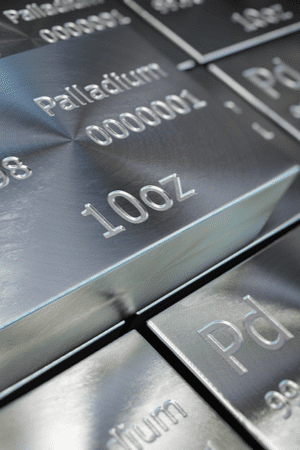What is palladium?
Palladium became known in 2018 and 2019 as a precious metal that could become unaffordable in the future. When this will be, nobody knows. This product is very scarce, and is only mined in a few places on earth. The problem is that palladium is increasingly used in industry, for example in the automotive industry. Imagine that everyone soon owns a car with a catalytic converter; then the palladium is gone in the blink of an eye. When you invest in palladium, you also have the option of buying palladium bars or coins.
Palladium was first mined in 1803, making it a young precious metal. In October 2017, the price of palladium reached $1,000. Of all the suppliers of palladium, Russia is the largest producer. Be careful if you drive a car with a catalytic converter: the value of palladium makes this part of your vehicle invaluable to car thieves.
Investing in precious metals
The investment world of precious metals has its peaks and troughs, just like all other products. However, the trend is mainly upwards, due to the combination of increasing demand and shrinking production. Recurring political unrest is the main cause of the shocks in the upward trend. If you want a good example of this, the precious metal gold provides a clear picture. Gold is often seen as a safe investment option, and rises sharply in times of unrest. Despite the fact that palladium is also very scarce, the price of this precious metal will mainly increase when its use increases. This is already clearly visible. That is why you have the opportunity to profit from the increases in the prices of palladium, and you can also invest well in it. But when do I invest enough in it and how do I choose the right moment? And what do I invest in then?
What is palladium used for?
As mentioned before, the largest part of palladium is used in the automotive industry, mainly in the design and production of catalytic converters. These products account for 65% of the total consumption of palladium on earth. About 20% of palladium is used in electronics, in equipment that you find at your dentist and sometimes also at jewelers. Countries such as China, which are large consumers of palladium, are increasingly focusing on the environment in the future. The total number of catalytic converters sold will increase as a result, and as a result the palladium price will also increase. Incidentally, China is not the only country where environmental requirements are becoming increasingly strict.

Investing in palladium shares or buying physical palladium?
Due to the scarcity of palladium, you can invest well in various companies that offer palladium. Some investors prefer something tangible and want to physically own precious metals. This is also possible with palladium, by means of bars and coins. You can purchase these products in all kinds of weights, from 1 troy ounce (which is 31.3 grams) to 1 kilo. UMICORE is the stamp that indicates the purity of palladium. The most famous coins are minted from 999.5/1000 pure palladium. Think of the Cook Islands Palladium or the Maple Leaf Palladium.
The biggest advantage of physically owning this precious metal is that you know for sure that you have a product. The downside is that you need a safe place to store the palladium, and you have to pay VAT on it. Investing in shares or ETFs is therefore easier for some investors. These products are also easier to trade through an online broker, with physical possession this is often less easy.
Finally: investing in palladium?
The biggest similarity between silver, gold, palladium and platinum is that these precious metals will only become more scarce. Although investing in these products is a good idea, no one knows when it is best to invest. Not investing in the raw materials does give the risk that you could miss out on the constant price increases or decreases and return percentages.
Compare brokers and start investing in commodities
Are you excited about investing in commodities, such as palladium, after reading this article? Compare brokers where you can trade in commodities and find the broker that suits you best!